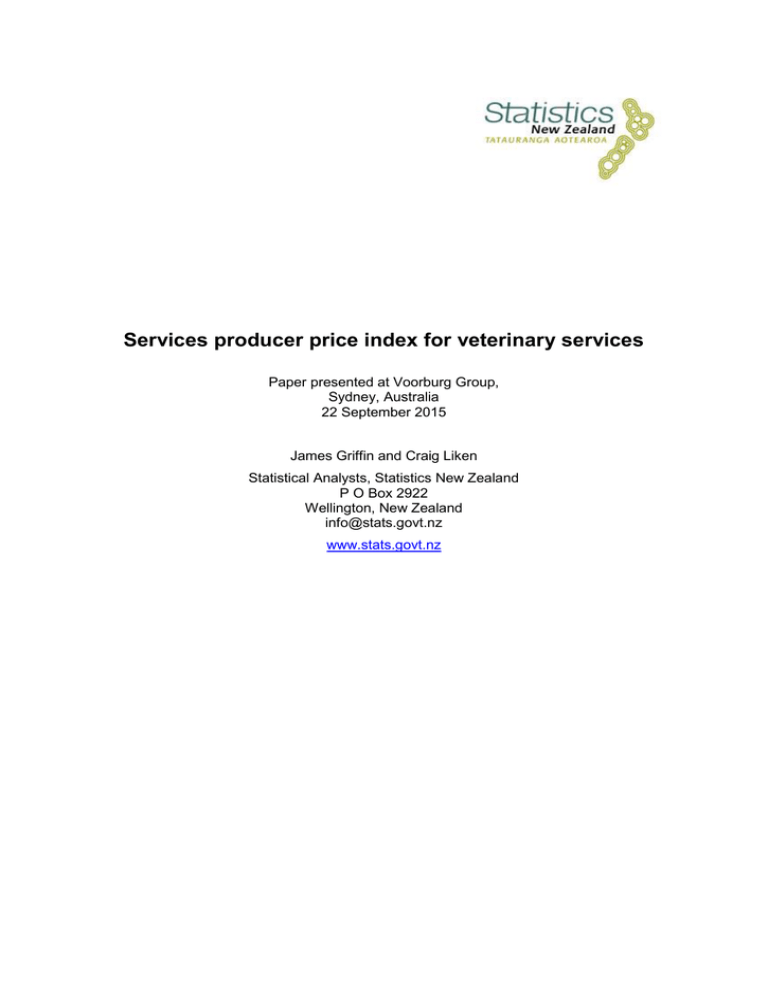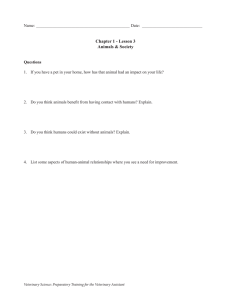Services producer price index for veterinary services
advertisement

Services producer price index for veterinary services Paper presented at Voorburg Group, Sydney, Australia 22 September 2015 James Griffin and Craig Liken Statistical Analysts, Statistics New Zealand P O Box 2922 Wellington, New Zealand info@stats.govt.nz www.stats.govt.nz Crown copyright © This work is licensed under the Creative Commons Attribution 3.0 New Zealand licence. You are free to copy, distribute, and adapt the work, as long as you attribute the work to Statistics NZ and abide by the other licence terms. Please note you may not use any departmental or governmental emblem, logo, or coat of arms in any way that infringes any provision of the Flags, Emblems, and Names Protection Act 1981. Use the wording 'Statistics New Zealand' in your attribution, not the Statistics NZ logo. Liability The opinions, findings, recommendations, and conclusions expressed in this paper are those of the authors. They do not represent those of Statistics New Zealand, which takes no responsibility for any omissions or errors in the information in this paper. Citation Griffin, J & Liken, C (2015, September). Producer price index for veterinary services. Paper presented at Voorburg Group, Sydney, Australia. Producer price index for veterinary services, by James Griffin & Craig Liken Introduction New Zealand is one of the few countries that has a producer price index (PPI) that includes veterinary services. In this paper, we explain where Statistics New Zealand classifies veterinary services in our industrial classification system, and how we measure price change for veterinary services. We also discuss how we collect turnover data for veterinary services, including the move away from survey data towards increased use of administrative data. Industry classification and structure The industry classification we use to compile the PPI is the New Zealand Standard Industrial Output Classification (NZSIOC). This classification has four levels, with publication currently at the second lowest level, level 3. The fourth (and lowest) level is calculated and used by our National Accounts team as deflators. We are currently reviewing our publishing level, and we expect to start publishing these level 4 indexes (subject to confidentiality) later in 2015. For international comparisons, the NZSIOC level 4 industry that relates to ISIC M7500 (Veterinary activities) is MN114 (Veterinary and other professional services). NZSIOC concords to the Australian and New Zealand Standard Industrial Classification 2006 (ANZSIC06), which in turn concords to ISIC. This is summarised in table 1. Table 1 Industry classification NZSIOC level 4 ANZSIC06 class ISIC MN114 – Veterinary and other professional services M697000 – Veterinary services M7500 – Veterinary activities MN114 – Veterinary and other professional services M699100 – Professional photographic services M7420 – Photographic activities (partial)* MN114 – Veterinary and other professional services M699900 – Other professional, scientific and technical services n.e.c. M7490 – Other professional, scientific and technical activities n.e.c. *This ISIC also includes photographic film processing which is a different ANZSIC class (S953200) This NZSIOC level 4 industry (MN114) covers more than veterinary services, however, the ANZSIC06 veterinary services class makes up about 70 percent of this NZSIOC. We do not calculate industry indexes at the ANZSIC06 class level, however we do collect information at this level when developing our NZSIOC indexes. The last time we collected information on the ANZSIC06 class for veterinary services, almost 95 percent of the output of this industry was for veterinary services. Pricing veterinary services in the PPI Our PPI is structured so that prices feed into commodity indexes. These commodity indexes then feed into our NZSIOC industry indexes. In order to explain how we price veterinary services in the PPI, we describe our commodity index for veterinary services. Our veterinary services commodity index concords with the Central Product Classification (CPC) level 5, as summarised in table 2. 3 Producer price index for veterinary services, by James Griffin & Craig Liken Table 2 Commodity classification Statistics NZ commodity CPC level 5 code CPC level 5 description Veterinary services 83510 Veterinary services for pet animals Veterinary services 83520 Veterinary services for livestock Veterinary services 83590 Other veterinary services We collect prices for approximately 50 products in this commodity, representing the first two CPC codes (veterinary services for pet animals and livestock). We do not currently price other veterinary services. Most of the weight is assigned to veterinary services for livestock because agriculture is a significant part of the New Zealand economy. Pricing of veterinary services for livestock is collected using a quarterly postal survey in the PPI. As vets need to visit farms to perform consultations and examinations, most of the prices we collect are visit- or time-based – for example, ‘vet fees (cattle) charge per hour’. There are some prices collected for specific diagnostic tests – for example, ‘ultrascan pregnancy diagnosis scan for 50 cows’. We collect prices from about 25 veterinary clinics and hospitals around New Zealand. Pricing of veterinary services for pets comes from the consumer price index (CPI). In the CPI, a quarterly postal survey is used to collect prices for veterinary services. The prices we collect are for a consultancy fee, the fee for spaying a six-month-old cat, and the fee for an annual adult dog vaccination against distemper, parvo-virus, hepatitis, and kennel cough. We collect prices from about 20 veterinary clinics and hospitals. Most prices collected for veterinary services show a price change every two to three years, with only a small number changing annually. Figure 1 shows the price index for veterinary services in the PPI. The annual average rate of change over the period was 3.4 percent. Figure 1 Price index for veterinary services commodity PPI veterinary services commodity index Base: December 2009 quarter (=100.0) Index 125.0 120.0 115.0 110.0 105.0 100.0 95.0 90.0 85.0 80.0 D M J 09 10 S D M 11 J S D M 12 J S D M 13 J S D M 14 J S D M 15 J Source: Statistics New Zealand The main challenge we face with pricing veterinary services is pricing to constant quality – ie ensuring that data suppliers provide prices for the same services each quarter. This is helped by 4 Producer price index for veterinary services, by James Griffin & Craig Liken ensuring that we specify products that we survey with enough detail so that data suppliers know exactly what to provide prices for. Measuring sub-annual turnover in veterinary services Sub-annually there are gaps in our coverage of turnover measures for the services industries. Under a programme of work known as the Statistical Architecture for Economic Statistics (SAFES), Statistics NZ is looking to fill some of these gaps. Under SAFES our current approach of sample surveying, supplemented by administrative data for smaller units, is being turned on its head. We will start to use administrative data sources wherever possible, and survey only where necessary. Veterinary services is one of the industries where the SAFES work is progressing – we will be producing a turnover measure for MN114 (Veterinary and other professional services) from the September 2015 quarter onwards. Data from at least 2010 will also be available when we release the series later this year. The data source for sub-annual turnover data for most industries, including veterinary services, will be New Zealand’s Goods and Services Tax (GST) return. GST is a comprehensive, valueadded tax levied at a constant rate (15 percent) on almost all goods and services in New Zealand. Businesses report their sales, purchases and tax-to-pay either monthly or two-monthly depending on size, with six-monthly reporting for very small businesses. We have now developed very robust methods of modelling the GST data from businesses with different filing frequencies. Veterinary services is an ideal industry to be covered using an administrative data source such as GST. The industry is dominated by small simple businesses with single locations and fewer than 20 employees. Almost all units file monthly, two-monthly, or six-monthly GST returns, with very few being part of complex units. Most of the industry employees (around 90 percent) are employed by these small businesses, and over 85 percent of turnover comes from these businesses. Data is also relatively timely, with around 90 percent of data available within 40 days of the end of the relevant quarter. Industries such as veterinary services, which are characterised by a large proportion of small units with no dominant businesses, are difficult to survey. Sample weights and sample errors tend to be high, response rates are low, and stratum changes can be challenging. Administrative data provides more reliable results and removes the survey response burden from small businesses. Using GST data under the SAFES model, we have produced a time series for MN114 (Veterinary and other professional services) that looks consistent and shows a stable seasonal pattern. Back data, needed for seasonal adjustment and for our customers, is also available, as GST has been levied for many years. Our National Accounts team is currently working on incorporating this new data into their processes for producing quarterly GDP. 5
